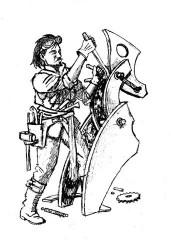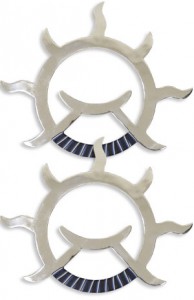I had some trouble deciding which of several sections of the Core Rulebook I should highlight next. Eventually I looked at the bits I was choosing between and went “why not all of them?”. Most were pretty short anyway, or at least the piece I wanted to highlight was.
So, you’ll find below six not-previously-public excerpts from the Core Rulebook, with a combined length of 14 pages. (As a reminder, 14 pages in my half-size format is about equal to seven pages of a more traditional RPG book.) That’s exactly 10% of my current Indesign files for the Core Rulebook, which go up to page 140, though enough of those pages are placeholders for images that it’s probably closer to 12% of the actual content.
So here they are, in the order they appear in the current draft, which also turned out sort them roughly from least to most I had to say about them.
This excerpt from the Battle System chapter features the Assist and Hamper actions, which are one of the most recent additions to the book. This was a response to a request from a playtester, who wanted more options for influencing the effectiveness of other combatants. It’s also a good example of how I’m trying to keep most subsystems down to a single half-size page, in this case including a substantial explanatory sidebar.
Several key rules for skills are found on this spread, including both the “Two-Roll Rule” that was recently a minor topic of discussion at ENWorld, and the rule for Complications (I refuse to call it “Fail Forward” for political reasons I won’t go into here, but it’s the same idea that usually goes under that name). Another example of how I’m trying to keep my explanations detailed enough to be easy to learn the rules from on first reading, yet succinct enough to work as a reference during actual play.
A spread from later in the skills chapter. This contains about two and a half of the three Lore specialties (including the answer to the ever-popular question “How do I learn a language?”), and most of one of the Perception ones.
Earlier tonight, I looked over the most comparable skills in a certain very popular d20-based game. One column of text in that system has a similar word count to one page in mine, and they use five columns, give or take, to cover pretty much the same ground I do here in two pages. And in those two pages, I also manage to squeeze some clarifications and advice into the sidebars, material you’d need to visit the publisher’s Web site to find for that rival system. Name of that system notwithstanding, I can’t help but think I did a better job of finding the path here.
A spread from a little later in the same chapter. On the recto, we have parts of two of the three Social specialties. The verso is probably more interesting. It consists entirely of one big sidebar, by far the largest one in the book (bigger, in fact, than any two others), in which I weigh in on one of the oldest debates in tabletop RPGs.
Most of this spread is devoted to the rules for alchemical items, like healing potions and bombs. The items themselves are in a table elsewhere, though there are details on a few specific ones, like Lazarus Crystals (if you know my sources of inspiration, you’ll have no trouble guessing why they’re described as feather-like and what I initially considered calling them).
This also includes the chakra rule for accessories. Accessories are miscellaneous magic items that work a lot like Final Fantasy VI‘s Relics. That was mostly a really good system, but a few things about it don’t translate well to a tabletop game – for example, it’s goofy to have Sprint Shoes and Hermes Sandals on the same character. Not that a tabletop game has the problem sprint shoes exist to solve, since by the nature of tabletop RPGs, you fast-forward past the boring travel bits just by saying you’re doing so – but you know what I mean. Anyway, the chakra rule lets me disallow such silly combinations in a reasonably principled way. It’s really more a matter of flavour than game balance, but it does give a way, if it’s needed, to keep people from using combinations of accessories that might be broken or confusing – just give the offending pair the same chakra and you never have to worry about it.
In the final version, this material will actually be organized quite differently. Instead of all being together like this, the notes on alchemical items (for example) will be right after the table that lists all the alchemical items and how they work. So this is a rare glimpse at what a chapter looks like when it’s only partially laid out. For a better idea of what the final version will be like, you want to look at:
This last one is four pages long (the others all consist of one two-page spread), and my comments on it are actually longer than those on the previous five put together.
This last sample consists of the basic weapons table plus the accompanying notes. This will give a better idea of how the gear chapter will ultimately look and feel, as this is pretty much how I want the other types of gear (armour, accessories, alchemical items, etc) presented. As an added bonus, some of these will fit on one two-page spread, which the weapons didn’t.
Some of the weapon choices are a bit unusual in the RPG world. For the remainder of this post, I want to talk about why the weapon selection is the way it is. A tremendous amount of thought went into this, enough that I can really only hit a few highlights here, but it’s more than enough for an entry given how much other ground I’ve already covered.
There’s a certain standard set of weapons found in nearly every fantasy RPG, tabletop or computerized. You probably know it. For the most part, it’s just the early Dungeons & Dragons weapon list (generally with some toning down of Gary Gygax’s polearm fetish), or at most, the set union of that and the Japanese weapons popularized by the 80s ninja craze. In other words, you’re basically looking at the most important medieval weapons, including all the massively cross-cultural ones, plus sometimes a sprinkling of cool martial-arts toys. (There’s a few standard weapons that don’t fit either description, but for the most part you won’t go wrong thinking of it in those terms. Even the exceptions are often explicable in terms of 80s pop culture; most obviously, the whip got added to the list at the height of Indiana Jones’ popularity.)
And there’s nothing wrong with that, but even given that definition there’s some pretty glaring omissions in that list. For example, the poleaxe was one of the most important medieval weapons, particularly crucial for defeating heavily armoured knights, but almost never shows up in an RPG for no better reason than because Gygax overlooked it. (The closest thing in standard D&D is the bardiche; I suppose a “greataxe” could be a poleaxe, but it’s seldom drawn or described like one, and in any case even that is a newer, post-Gygax addition.)
An even bigger case of missing the boat on history is the widespread notion that plate armour is more “medieval” than firearms. In fact, the two were developed at about the same time and coexisted for upwards of three centuries in Europe alone, and other military uses of gunpowder (cannon and bombs) actually predate the earliest full suits of plate armour. The main reason firearms are included in Fantasy Infinity is the desired “steampunk” feel, but doing what I can to set the record straight on this point runs a close second. That guns are here called “boom-sticks” is, of course, a nod to one of the greatest comedies of all time (I mean that completely unironically), Army of Darkness.
On the cool martial arts toy side of things, the Japan-centric emphasis on ninjas caused a few weapons to be undeservedly overlooked, like China’s Wind And Fire Wheels. I’m at least as much of a Japanophile as the median North American nerd, but that’s no excuse for ignoring a weapon with a name as awesome as “Wind and Fire Wheels”. So they crop up here, mostly to give low-level dans an easy way to get an acceptable damage cap. (At higher levels, the higher Recovery of W&FWs should make unarmed strikes more desirable.)
There are also, obviously, some purely fantasy weapons on the list – wands, orbs, and some staffs. These overtly magical weapons don’t seem like they’d be at all out of place in a world as magic-heavy as many JRPG settings seem to be. They were included mainly because my totally subjective feelz are that overtly magical tools are a better solution to the “mages with crossbows feel wrong” problem than the currently fashionable one – unlimited use of certain low-powered spells. Less subjectively, treating these as weapons is also a better fit for Fantasy Infinity character building.
In addition, these items are something of a nod to the JRPG tradition of including staffs and rods as “weapons” for mages. Like their JRPG counterparts, these weapons suck for physical attacks, but aid or complement spellcasting in some way. Indeed, orbs were called “rods” at one point, and as a further nod in that direction their description in the Character Reference (which will probably be one of the next few things I preview) mentions that orbs are frequently mounted on short rods.
I changed “rod” to “orb” mostly because I was having trouble coming up with an explanation of what a “rod” was that clearly distinguished them from staffs, wands, and maces. (And didn’t make them seem like magical dildoes, a problem 4th Edition D&D tragically failed to avoid, though more through its illustrations than its text.) The clearest ways to do it involved directly referencing game mechanics, which felt wrong, because I could explain the other eleven weapon types in purely in-character terms. Changing rods to orbs obviated this problem.
Even though some of the 12 weapon categories in the Origins Set are very broad, its weapon list has some notable omissions of its own. The whip, sling, chakram, and many polearms have no place in the current typology. At least some of these are liable to appear as new weapon types in the Champions Set or some other later release, along with a very ahistorical scythe for necromancers. There will be ways for some of the existing classes to substitute one of these for one of the standard weapons; in fact, I have a much clearer idea of how that will work than I do of the mechanics of the weapons themselves. In any case, writing these expansion rules down in playable detail is a long way off; right now, I have my hands full with just the Origins Set!

